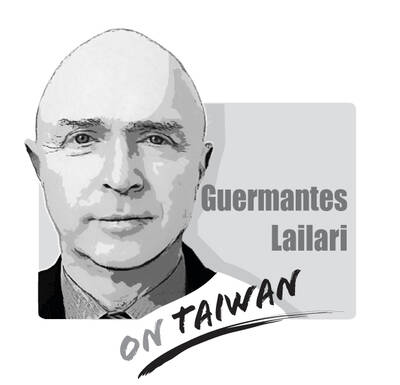Since launching ChatGPT two years ago, OpenAI chief executive officer Sam Altman has maintained that his business is fueled by a few key ingredients: chips, data and money. The more of those three elements you shovel into his firm, like coal into a steam train’s furnace, the more powerful artificial intelligence (AI) it will produce.
Enter a tiny company from China called DeepSeek to blow a hole in that formula, with an AI model that is just as powerful and built for a fraction of the cost.
However, there’s more to this David and Goliath story than just one company — or even China.

Illustration: Mountain People
Across the world, similar open-source models are being built, ready to eat into Altman’s market share with systems that are vastly cheaper or even free to use. That is an unnerving prospect for businesses like OpenAI and Anthropic, whose primary path to profitability is selling access to a foundation model for a higher price. (Alphabet Inc’s Google and Microsoft Corp at least have cloud and software businesses to fall back on.)
Publicly available models like DeepSeek might not reign supreme in the end, but they could win an uncomfortably large share of the pie, and fulfill promises that Altman has neglected around openness and collaboration.
Upon its founding, OpenAI pledged that its researchers “will be strongly encouraged to publish their work” and that its patents would be “shared with the world.”
“We’ll freely collaborate with others across many institutions and expect to work with companies to research and deploy new technologies,” it said.
However, Gary Marcus, a professor emeritus at New York University, has long bemoaned OpenAI’s opacity and warned of an AI market crash.
“DeepSeek’s paper on [its new AI model known as] R1 was more transparent than anything I’ve seen from OpenAI since GPT-3,” Marcus says.
That openness is part of a shift happening in China. DeepSeek was founded by a hedge fund entrepreneur named Liang Wenfeng (梁文鋒), who pulled together his former employees and dozens of doctorate holders from Chinese universities to try and build human-level AI. He then harnessed 10,000 chips acquired from Nvidia Corp in 2021 (before a US crackdown on chip exports), reportedly using one-50th of the computing power that tech giants like Google, Microsoft and OpenAI have.
As those companies try and explain their eye-wateringly high AI capex numbers to investors, they will do their best to offer some hope. Having fretted about the diminishing returns of so-called scaling laws that underpinned Altman’s more-is-better formula, here they now have the blueprints for circumventing those requirements, thanks to DeepSeek.
The Chinese company has put most of the details about R1 on the Internet, something that OpenAI and Google would not do today. Its breakthrough is essentially a novel approach to so-called reward modeling, according to one summary of the findings.
Meta Platforms Inc engineers are already poring over those details, and in the coming weeks and months we could see Mark Zuckerberg and his big-tech peers release new AI models that are far more efficient.
That will not be straightforward, as DeepSeek is not technically “open source,” according to the Open Source Initiative (OSI), a global authority that certifies software licenses.
“They do not provide the source code to process and filter and train the data, nor the information about the training data,” a spokesman for the OSI tells me. “Others would have to build this from scratch based solely on the paper they published.”
However, as a so-called open-weight system, DeepSeek can still provide the crucial model parameters that others can copy and improve upon, unlike OpenAI, which keeps its models locked in a black box.
DeepSeek itself was built on the work of others. The company says its AI was built on Meta’s open-weight Llama model. Microsoft is also looking into whether DeepSeek built its AI with help from OpenAI’s technology, albeit without proper permission, and likely causing consternation in San Francisco.
You can play the world’s tiniest violin for OpenAI, a company that scraped the copyrighted work of thousands of artists and writers for its own commercial gain.
Free, highly capable AI systems do not just stop with DeepSeek. There are more open-source AI products coming from China, such as YuE, which generates full pop music tracks complete with warbled lyrics, and Alibaba Group Holding’s Qwen, which creates AI agents.
China’s shift toward building open-source models has come about in the past few years, driven by US export controls, government support and the impact of Meta’s Llama, which several Chinese tech firms have been enthusiastically fine-tuning for their own applications, according to Computer Weekly.
For the entrenched giants of Silicon Valley, the real threat is not just China, but the way Chinese tech firms could fuel even greater momentum for the open-source movement in other parts of the world — like France, home to promising open-source AI firms Mistral AI and Hugging Face Inc, and the US, where research collective EleutherAI has been influential in creating models like GPT-J and GPT-NeoX.
Of course, open-source AI has downsides, the obvious one being misuse by bad actors. And while DeepSeek’s new model has solved the problem of cost, it has not solved hallucinations. Plenty of examples exist on social media of users jailbreaking R1 to get around its Chinese Communist Party-friendly filters. And while the model was cheap to build, it is still relatively expensive to run, Marcus points out.
Yet DeepSeek is still giving open-source AI newfound credibility among software builders. Developers on forums like X have been showing off all the apps they are building on DeepSeek’s free platform.
One said he used it to clone the AI-answer engine Perplexity without writing any code.
Another developer said he harnessed R1 to build an app that lets you ask questions about any PDF file.
OpenAI’s business of building foundation models has become commoditized. The real economic potential is for those building products on top of all that infrastructure, or on top of platforms like DeepSeek’s that are free to use.
The irony is rich. When OpenAI launched in 2015, it promised to “freely collaborate” and share its patents with the world. Instead, in its galactically ambitious quest for human-level AI, it began morphing into exactly what it set out to disrupt: an opaque, money-hungry tech giant, which is now being challenged by genuinely open AI.
Altman convinced the world that building powerful AI required massive resources, but he is now learning that his moat is not that deep after all. Perhaps the future belongs not to those who can spend the most, but to those who dare to share their workings with the world.
Parmy Olson is a Bloomberg Opinion columnist covering technology. She is a former reporter for the Wall Street Journal and Forbes. This column does not necessarily reflect the opinion of the editorial board or Bloomberg LP and its owners.
A response to my article (“Invite ‘will-bes,’ not has-beens,” Aug. 12, page 8) mischaracterizes my arguments, as well as a speech by former British prime minister Boris Johnson at the Ketagalan Forum in Taipei early last month. Tseng Yueh-ying (曾月英) in the response (“A misreading of Johnson’s speech,” Aug. 24, page 8) does not dispute that Johnson referred repeatedly to Taiwan as “a segment of the Chinese population,” but asserts that the phrase challenged Beijing by questioning whether parts of “the Chinese population” could be “differently Chinese.” This is essentially a confirmation of Beijing’s “one country, two systems” formulation, which says that

“History does not repeat itself, but it rhymes” (attributed to Mark Twain). The USSR was the international bully during the Cold War as it sought to make the world safe for Soviet-style Communism. China is now the global bully as it applies economic power and invests in Mao’s (毛澤東) magic weapons (the People’s Liberation Army [PLA], the United Front Work Department, and the Chinese Communist Party [CCP]) to achieve world domination. Freedom-loving countries must respond to the People’s Republic of China (PRC), especially in the Indo-Pacific (IP), as resolutely as they did against the USSR. In 1954, the US and its allies
Indian Prime Minister Narendra Modi arrived in China yesterday, where he is to attend a summit of the Shanghai Cooperation Organization (SCO) with Chinese President Xi Jinping (習近平) and Russian President Vladimir Putin today. As this coincides with the 50 percent US tariff levied on Indian products, some Western news media have suggested that Modi is moving away from the US, and into the arms of China and Russia. Taiwan-Asia Exchange Foundation fellow Sana Hashmi in a Taipei Times article published yesterday titled “Myths around Modi’s China visit” said that those analyses have misrepresented India’s strategic calculations, and attempted to view
When Chinese President Xi Jinping (習近平) stood in front of the Potala Palace in Lhasa on Thursday last week, flanked by Chinese flags, synchronized schoolchildren and armed Chinese People’s Liberation Army (PLA) troops, he was not just celebrating the 60th anniversary of the establishment of the “Tibet Autonomous Region,” he was making a calculated declaration: Tibet is China. It always has been. Case closed. Except it has not. The case remains wide open — not just in the hearts of Tibetans, but in history records. For decades, Beijing has insisted that Tibet has “always been part of China.” It is a phrase